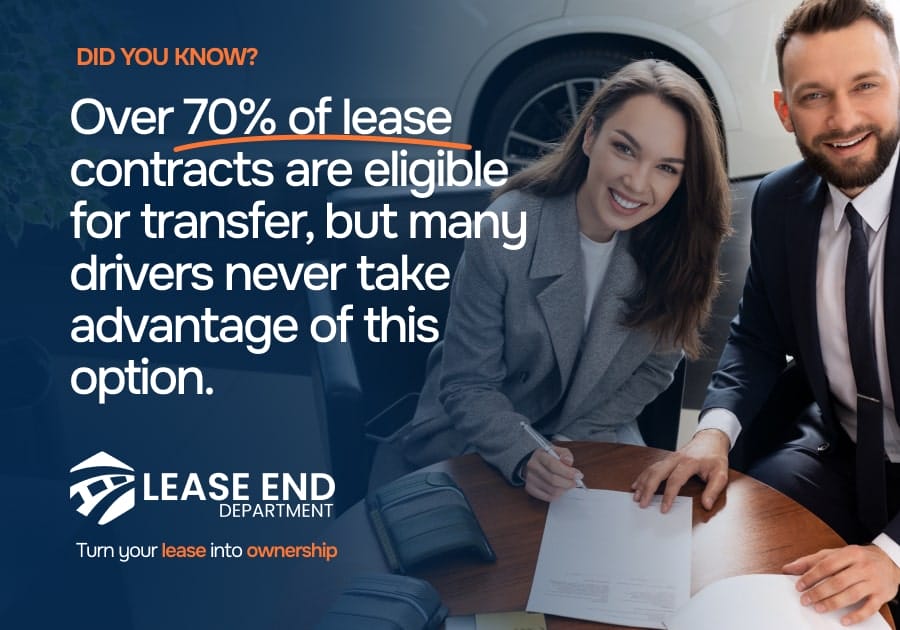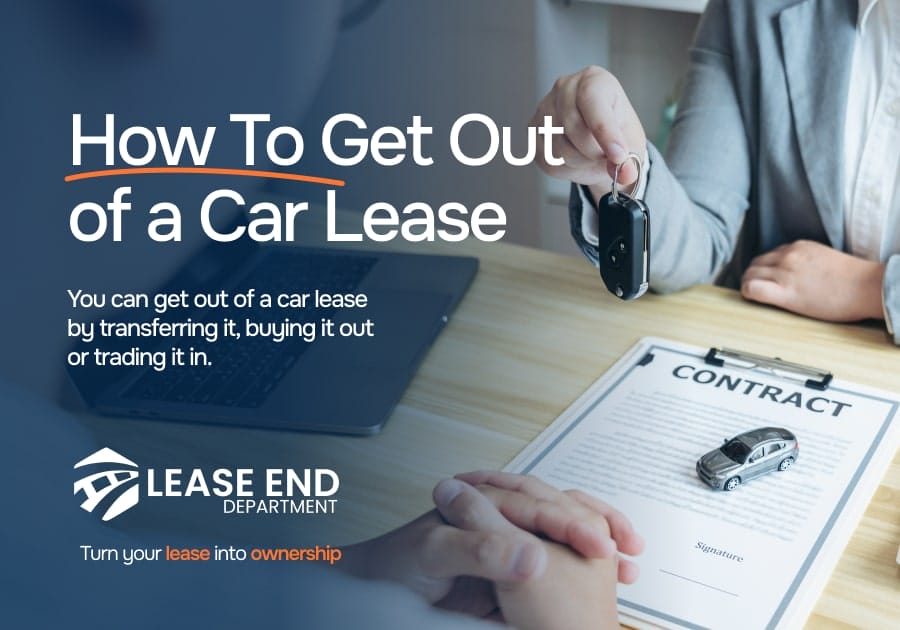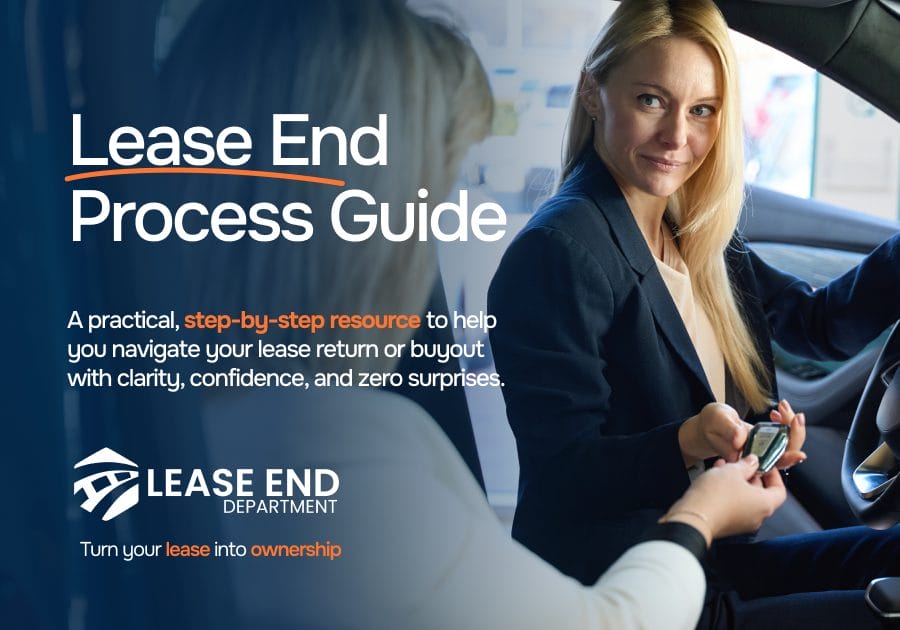Yes, You Can End Your Car Lease Early
- Top exit strategies include lease transfers, early buyouts, trade-ins, or negotiating with your lender
- Lease contracts often include penalties for early termination, but there are legal and strategic ways to reduce or avoid them
- Lease buyouts can be a smart move if your vehicle’s value is close to or above its payoff amount
- Penalties for wear, mileage, and fees can often be reduced through planning, early inspections, or the right financing partner
How to End a Car Lease Early
Early termination fees can cost you 1.0 to 2.5 times your base monthly payment, depending on how far along you are in the lease.
Termination fees aside, many drivers are surprised to learn that early exits are not only possible but sometimes financially advantageous, especially if your car holds more value than its remaining payoff amount.
In this guide, you’ll learn:
- The most effective ways to exit a lease
- Why getting out of a car lease early is possible
- What penalties to expect and how to avoid them
- When a lease buyout might be your best option
Best Options to Get Out of a Car Lease
Ending a lease early can be tricky, but it’s not impossible.
Let’s explore the most effective methods for getting out of a car lease.
1. Lease Transfer
A lease transfer lets you pass your lease on to someone else who agrees to take over your payments and contract terms.
To manage a lease transfer, you can:
- Use platforms like Swapalease or LeaseTrader to connect with interested buyers
- Most lease companies charge a $100 to $500 transfer fee, and some may still hold you liable if the new driver defaults
- Not all lenders allow transfers; check your contract or call your leasing company
Quick savings example: If your payment is $425/month with 12 months left, transferring it could save you over $5,000.
2. Buy Out Your Lease Early
Buying out your lease means purchasing the car before the contract ends.
This would work the best if:
- Your car’s current market value is higher than the residual value
- You plan to keep the car long term
- You want to avoid fees tied to wear and mileage
Request your payoff amount from the leasing company and compare it to your car’s current value on Edmunds, Kelley Blue Book, or Carvana.
Example: You leased a car with a $17,000 residual value, but similar used models now sell for $20,000+. Buying out the lease and keeping or reselling the vehicle could be a smart equity play.


3. Trade in Your Lease for Another Vehicle
Trading in your lease involves taking the car to a dealer and using it as a trade toward another lease or loan.
The best approach is to:
- Ask the dealer to appraise your vehicle and compare that to your lease payoff
- Evaluate if your vehicle is worth more than the payoff, because that equity can lower your next down payment
- See if it’s worth less; you may still be able to roll the difference into a new deal, but that increases your future payments
Example: If your lease payoff is $20,000 and a dealer offers $21,000 for the trade, that $1,000 can go toward your next vehicle.
4. End Your Lease Early Through a Dealership Program
Some manufacturers offer early termination or pull-ahead programs, where they waive a few remaining payments if you lease another vehicle with them.
What to look for:
- These promotions often run seasonally or during end-of-model-year clearance events
- They usually apply only if your car is in good condition and you’re within a set number of months from the original end date (typically 3 to 6 months)
- Always confirm there are no hidden costs like dealer fees, inflated interest rates, or negative equity rollovers
Example: If you owe four more payments of $399, and a dealership covers them under a pull-ahead offer, that’s $1,596 saved if the next lease terms are competitive.
5. Surrender the Vehicle as a Last Resort
Voluntarily returning the car to the leasing company is called voluntary surrender and should only be done if no other option is feasible.
Possible consequences you might encounter:
- You’ll likely owe remaining payments, damage fees, and early termination penalties
- Your credit report will reflect the surrender, which may impact your score
- You may be contacted by collections for any outstanding balance
When to consider it:
- If you’re experiencing severe financial hardship and can’t refinance, sell the leased car, or transfer the lease.
- Talk to your lender first; some offer payment deferrals or hardship options.
Example: If you owe $8,000 in future lease payments and fees and the car is worth much less than the payoff, this option may stop further losses, but only after all other options are ruled out.
Most Common Penalties When Ending Car Lease
Common early lease penalties include:
- Remaining monthly payments: You could be responsible for the full balance left on your lease. If your payment is $400 and you have 10 months left, you could owe $4,000
- Early termination fee: A flat fee outlined in your lease agreement, often between $200 and $500
- Disposition fee: A fee (usually $300 to $500) for returning the car at the end of the lease
- Excess wear and tear: Charges for interior or exterior damage beyond normal use
- Excess mileage charges: Typically 15 to 25 cents per mile over your contract limit
How To Get Out of a Car Lease Early Without Penalties
However, some of the most effective penalty-free strategies are:
- Transferring your lease to another qualified driver through a lease exchange platform
- Buying out your lease early if your vehicle’s market value justifies the payoff amount
- Trading in your lease for another car, especially if you’ve built equity
- Working with your dealer or leasing company to take advantage of promotions or hardship programs


When implementing these strategies, here are also a few things you should consider.
1. Time Your Exit
The closer you are to the natural end of your lease, the fewer penalties you’re likely to face. Some lenders may offer early termination options or waive the last few payments if you initiate a new lease with them.
To avoid penalties, you should:
- Review your contract around the 12- to 18-month mark of a 36-month lease to understand your payoff and early exit terms.
- Watch for dealer pull-ahead offers, which often waive up to three remaining payments
- If your car’s market value is higher than your buyout price, consider an early buyout; it could save money and eliminate lease-end charges.
2. Inspect Wear and Tear
One of the most common end-of-lease costs comes from unexpected wear and tear charges.
To minimize the risk, you should:
- Get a pre-return inspection (often offered for free by your leasing company) at least 30 to 60 days before your lease ends.
- Fix minor issues like cracked windshields, dents, worn tires, or upholstery damage before returning the vehicle.
- Check your contract’s wear and tear guidelines so you know what counts as “excessive.”
Example: A small dent might cost you $400 at lease-end, but repairing it in advance at an independent body shop may only cost $150 to $200.
3. Manage Excess Mileage
Mileage overages can lead to some of the steepest penalties, usually 15 to 25 cents per mile over your limit.
To avoid excess mileage, you should:
- Track your mileage monthly and compare it to your lease’s allowance (commonly 10,000 to 15,000 miles per year).
- If you’re on pace to exceed it, contact your leasing company, as some allow you to buy extra miles in advance at a discount.
- Explore a lease buyout if you’re far over the limit and want to avoid paying thousands in overage fees.
Example: If you exceed your lease by 6,000 miles at 25 cents per mile, you’ll owe $1,500, but buying extra miles in advance may cut that in half.
Tips On Getting Out of a Car Lease Early
Most lenders and dealers offer multiple paths for early termination, some with lower risk and cost than others.
Early lease exit is possible because:
- Lease terms are negotiable: Many lenders will work with you if you’re proactive and transparent.
- You’re not the only one who wants flexibility: There’s a market for people looking to take over existing leases through transfer programs.
- Vehicles hold value: If your leased car is worth more than its payoff amount, you may have equity you can use to your advantage in a buyout or trade-in.
- There are tools and services to help: Partners like Lease End Department can help guide you through buyouts or transfers without relying on the dealership.
Ending Car Lease Early: Key Takeaways
- You can get out of a car lease early and sometimes even penalty-free by using the right exit strategy.
- Lease transfers and buyouts are two of the most effective ways to exit a lease without damaging your credit or overpaying.
- Timing, condition of your vehicle, and market value all play a role in determining your options.
Lease End Department Can Help You With Early Lease Exit
Lease End Department helps drivers like you transition out of a lease with less stress, fewer surprises, and smarter financial outcomes.
If you ride with us, you will be able to:
- Review your lease terms and payoff details: The team helps you understand your contract and determine whether a buyout, transfer, or trade-in is the most cost-effective option.
- Explore personalized loan and buyout options: Whether you want to keep your current vehicle or refinance the lease, they’ll show you competitive loan offers that match your budget and credit profile.
- Avoid dealership markups and hidden fees: Lease End Department handles the paperwork directly and helps you bypass common dealership add-ons and inflated buyout structures.
- Get full support with registration and DMV paperwork: From titling to license plates, everything is handled for you so you can skip the long lines and tedious forms.
In addition, you can use our helpful tools to plan your move:
- Pre-approval form to check eligibility and loan rates
- Payment calculator to estimate your lease buyout or loan cost
Whether you’re a few months from lease-end or ready to exit now, Lease End Department gives you a clear, professional path forward with no dealership pressure and no unnecessary penalties.




